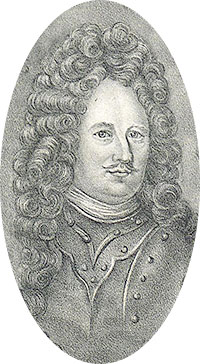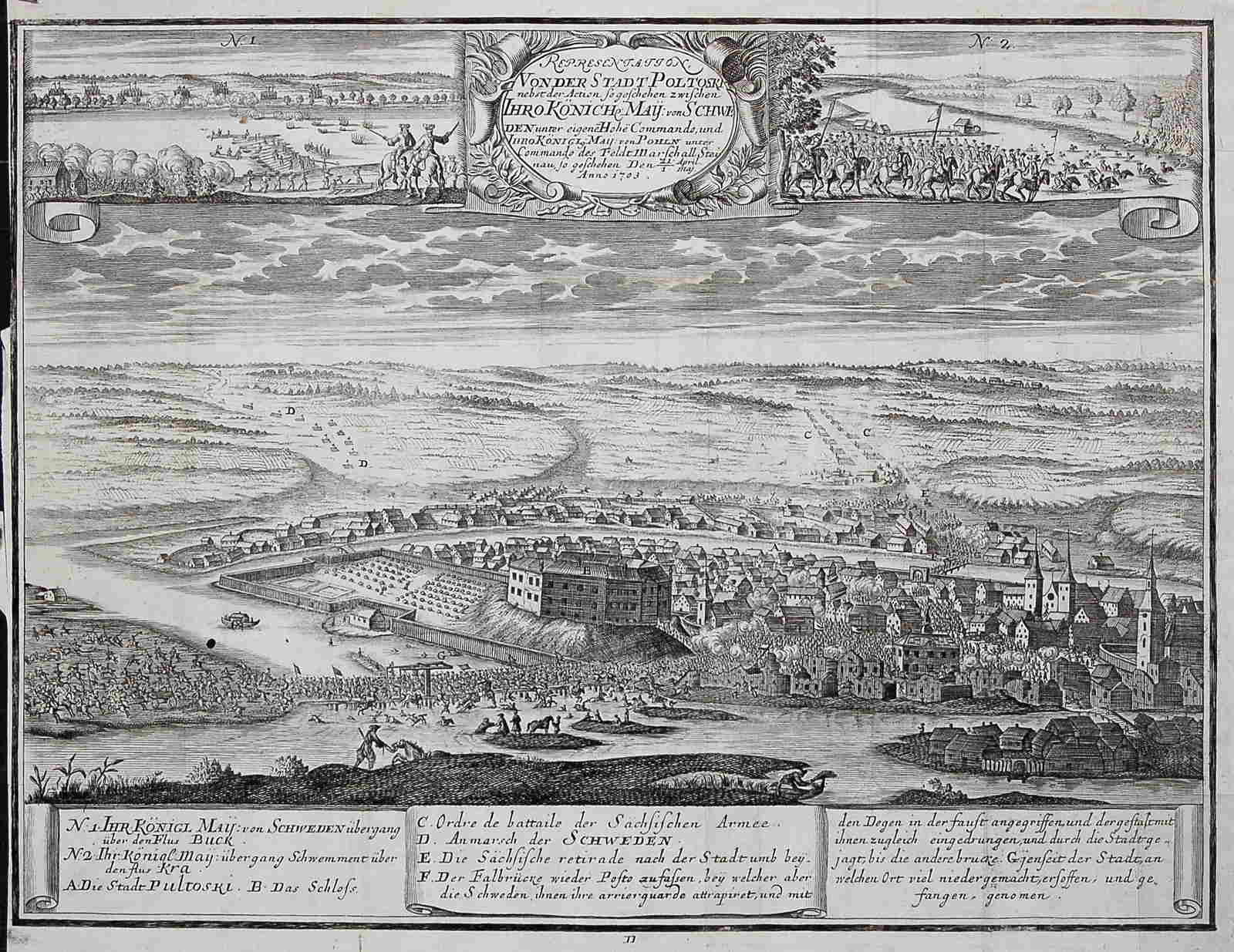|
Adam Heinrich Von Steinau
Adam Heinrich Graf von Steinau (died 1712) was a Saxon Generalfeldmarschall. Steinau served in the Bavarian contingent in the 1685‚Äď1688 campaign in Ottoman Hungary against the Ottoman Empire. He then participated in the War of the Grand Alliance against France under Charles V, Duke of Lorraine and in the successful siege of Mainz in 1689. Later he entered the service of the Republic of Venice in the 1695 war against the Ottoman Empire. In 1695‚Äď96 he was in the service of the Saxon elector Frederick August I (Augustus II the Strong, King of Poland) as the commander of the imperial troops in Royal Hungary in the continuous war with the Ottoman Turks. On 27 August 1699 Steinau was promoted to the rank of the Generalfeldmarschall. With his Saxon troops he participated on behalf of Augustus II the Strong in the Great Northern War defending Livonia in the Courland campaign, and in February ‚Äď November 1700 the Siege of Riga. In July 1700 he won a battle in Jungfernhof (JumpravmuiŇ ... [...More Info...] [...Related Items...] OR: [Wikipedia] [Google] [Baidu] |
Electorate Of Saxony
The Electorate of Saxony, also known as Electoral Saxony (German: or ), was a territory of the Holy Roman Empire from 1356‚Äď1806. It was centered around the cities of Dresden, Leipzig and Chemnitz. In the Golden Bull of 1356, Emperor Charles IV designated the Duchy of Saxe-Wittenberg an electorate, a territory whose ruler was one of the prince-electors who chose the Holy Roman emperor. After the extinction of the male Saxe-Wittenberg line of the House of Ascania in 1422, the duchy and the electorate passed to the House of Wettin. The electoral privilege was tied only to the Electoral Circle, specifically the territory of the former Duchy of Saxe-Wittenberg. In the 1485 Treaty of Leipzig, the Wettin noble house was divided between the sons of Elector Frederick II into the Ernestine and Albertine lines, with the electoral district going to the Ernestines. In 1547, when the Ernestine elector John Frederick I was defeated in the Schmalkaldic War, the electoral district and el ... [...More Info...] [...Related Items...] OR: [Wikipedia] [Google] [Baidu] |
Otto Vellingk
Count Otto Ottoson Vellingk (1649- 1708) was a Swedish general during the Great Northern War. Biography He was born in Jama in Swedish Ingria to Otto Gotthardsson Vellingk and Christina Nilsdotter Mannersk√∂ld. In 1664, Vellingk became a lieutenant with the Swedish regiment at Bremen. He subsequently entered French service in 1666 and was promoted in 1670 to Colonel in the French army. He was promoted to general in the Swedish Army during 1698. He participated in key battles of Great Northern War including: the Battle of Narva in 1700, and the Crossing of Daugava near Riga in 1701. He participated in the Battle of Klissow on 9 July 1702. He was in the Battle of Punitz on 28 October 1704. He was made a royal advisor in 1705, and ennobled as a count in 1706. See also *Great Northern War The Great Northern War (1700‚Äď1721) was a conflict in which a coalition led by the Tsardom of Russia successfully contested the supremacy of the Swedish Empire in Northern, Centr ... [...More Info...] [...Related Items...] OR: [Wikipedia] [Google] [Baidu] |
1712 Deaths
Year 171 ( CLXXI) was a common year starting on Monday (link will display the full calendar) of the Julian calendar. At the time, it was known as the Year of the Consulship of Severus and Herennianus (or, less frequently, year 924 ''Ab urbe condita''). The denomination 171 for this year has been used since the early medieval period, when the Anno Domini calendar era became the prevalent method in Europe for naming years. Events By place Roman Empire * Emperor Marcus Aurelius forms a new military command, the ''praetentura Italiae et Alpium''. Aquileia is relieved, and the Marcomanni are evicted from Roman territory. * Marcus Aurelius signs a peace treaty with the Quadi and the Sarmatian Iazyges. The Germanic tribes of the Hasdingi (Vandals) and the Lacringi become Roman allies. * Armenia and Mesopotamia become protectorates of the Roman Empire. * The Costoboci cross the Danube (Dacia) and ravage Thrace in the Balkan Peninsula. They reach Eleusis, near Athens, and destr ... [...More Info...] [...Related Items...] OR: [Wikipedia] [Google] [Baidu] |
17th-century Births
The 17th century lasted from January 1, 1601 ( MDCI), to December 31, 1700 ( MDCC). It falls into the early modern period of Europe and in that continent (whose impact on the world was increasing) was characterized by the Baroque cultural movement, the latter part of the Spanish Golden Age, the Dutch Golden Age, the French ''Grand Siècle'' dominated by Louis XIV, the Scientific Revolution, the world's first public company and megacorporation known as the Dutch East India Company, and according to some historians, the General Crisis. From the mid-17th century, European politics were increasingly dominated by the Kingdom of France of Louis XIV, where royal power was solidified domestically in the civil war of the Fronde. The semi-feudal territorial French nobility was weakened and subjugated to the power of an absolute monarchy through the reinvention of the Palace of Versailles from a hunting lodge to a gilded prison, in which a greatly expanded royal court could be more easily k ... [...More Info...] [...Related Items...] OR: [Wikipedia] [Google] [Baidu] |
PlzeŇą
PlzeŇą (; German and English: Pilsen, in German ) is a city in the Czech Republic. About west of Prague in western Bohemia, it is the Statutory city (Czech Republic), fourth most populous city in the Czech Republic with about 169,000 inhabitants. The city is known worldwide for Pilsner beer, created by Bavarian brewer Josef Groll in the city in 1842. Administrative division PlzeŇą is divided into ten boroughs, which are further divided into 25 administrative parts (in brackets): *PlzeŇą 1-Bolevec (Bolevec and Severn√≠ PŇôedmńõst√≠) *PlzeŇą 2-Slovany (BoŇĺkov, ńĆernice (partly), Doudlevce (partly), HradiŇ°tńõ, Koterov, Lobzy (partly) and V√Ĺchodn√≠ PŇôedmńõst√≠ (partly)) *PlzeŇą 3-Bory (Doudlevce (partly), JiŇĺn√≠ PŇôedmńõst√≠, Litice (partly), Nov√° Hospoda, Radobyńćice, SkvrŇąany, Valcha, VnitŇôn√≠ Mńõsto and V√Ĺchodn√≠ PŇôedmńõst√≠ (partly)) *PlzeŇą 4-Doubravka (Bukovec, ńĆerven√Ĺ Hr√°dek, Doubravka, Lobzy (partly), √öjezd and V√Ĺchodn√≠ PŇôedmńõst√≠ (partly)) *PlzeŇą 5-KŇ ... [...More Info...] [...Related Items...] OR: [Wikipedia] [Google] [Baidu] |
Netunice
Netunice is a municipality and village in PlzeŇą-South District in the PlzeŇą Region of the Czech Republic. It has about 200 inhabitants. Netunice lies approximately south of PlzeŇą and south-west of Prague Prague ( ; cs, Praha ; german: Prag, ; la, Praga) is the capital and List of cities in the Czech Republic, largest city in the Czech Republic, and the historical capital of Bohemia. On the Vltava river, Prague is home to about 1.3 milli .... Demographics References Villages in PlzeŇą-South District {{PlzeŇą-geo-stub ... [...More Info...] [...Related Items...] OR: [Wikipedia] [Google] [Baidu] |
Nebílovy
Neb√≠lovy (german: Nebillau) is a municipality and village in PlzeŇą-South District in the PlzeŇą Region of the Czech Republic. It has about 400 inhabitants. Neb√≠lovy lies approximately south of PlzeŇą and south-west of Prague. Demographics Sights Neb√≠lovy is known for the Baroque Neb√≠lovy Castle designed by Jakub Auguston Jakub Auguston Jr. (born Giacomo Agustoni; c. 1668, possibly in Rome , established_title = Founded , established_date = 753 BC , founder = King Romulus (legendary) , image_map = Map of comune of Rome (metropol .... References External links * Villages in PlzeŇą-South District {{PlzeŇą-geo-stub ... [...More Info...] [...Related Items...] OR: [Wikipedia] [Google] [Baidu] |
Chlumńćany (PlzeŇą-South District)
Chlumńćany is a municipality and village in PlzeŇą-South District in the PlzeŇą Region of the Czech Republic. It has about 2,500 inhabitants. Chlumńćany lies approximately south of PlzeŇą and south-west of Prague Prague ( ; cs, Praha ; german: Prag, ; la, Praga) is the capital and List of cities in the Czech Republic, largest city in the Czech Republic, and the historical capital of Bohemia. On the Vltava river, Prague is home to about 1.3 milli .... Administrative parts The village of Hradńćany is an administrative part of Chlumńćany. References Villages in PlzeŇą-South District {{PlzeŇą-geo-stub ... [...More Info...] [...Related Items...] OR: [Wikipedia] [Google] [Baidu] |
ŇĹinkovy
ŇĹinkovy (german: Schinkau, Zinkau) is a market town in PlzeŇą-South District in the PlzeŇą Region of the Czech Republic. It has about 800 inhabitants. ŇĹinkovy lies approximately south of PlzeŇą and south-west of Prague Prague ( ; cs, Praha ; german: Prag, ; la, Praga) is the capital and largest city in the Czech Republic, and the historical capital of Bohemia. On the Vltava river, Prague is home to about 1.3 million people. The city has a temperate .... Administrative parts Villages of BŇôez√≠, ńĆepinec and KokoŇôov are administrative parts of ŇĹinkovy. Notable people * Johann Baptist Bohadsch (1724‚Äď1768), German botanist and pharmacist References External links * Populated places in PlzeŇą-South District Market towns in the Czech Republic {{PlzeŇą-geo-stub ... [...More Info...] [...Related Items...] OR: [Wikipedia] [Google] [Baidu] |
Swedish Empire
The Swedish Empire was a European great power that exercised territorial control over much of the Baltic region during the 17th and early 18th centuries ( sv, Stormaktstiden, "the Era of Great Power"). The beginning of the empire is usually taken as the reign of Gustavus Adolphus, who ascended the throne in 1611, and its end as the loss of territories in 1721 following the Great Northern War. After the death of Gustavus Adolphus in 1632, the empire was controlled for lengthy periods by part of the high nobility, such as the Oxenstierna family, acting as regents for minor monarchs. The interests of the high nobility contrasted with the uniformity policy (i.e., upholding the traditional equality in status of the Swedish estates favoured by the kings and peasantry). In territories acquired during the periods of ''de facto'' noble rule, serfdom was not abolished, and there was also a trend to set up respective estates in Sweden proper. The Great Reduction of 1680 put an end to th ... [...More Info...] [...Related Items...] OR: [Wikipedia] [Google] [Baidu] |
Battle Of PuŇātusk (1703)
The Battle of PuŇātusk took place on April 21, 1703 in PuŇātusk during the Great Northern War. The Swedish army under the command of Charles XII defeated the Saxon army under Adam Heinrich von Steinau. Charles later went on to take ToruŇĄ (Thorn) in December.Tucker, S.C., 2010, A Global Chronology of Conflict, Vol. Two, Santa Barbara: ABC-CLIO, LLC, p. 691. Background In the first months of 1703 the war in Poland ceased. In March, Charles XII broke with his army in the direction of Warsaw, which he reached at the beginning of April. At the beginning of April 1703 August II left Dresden for Thorn and Marienburg in order to begin the new campaign from there. After the defeat in the previous year in the Battle of Klissow, August II used the time to build a new Saxon-Lithuanian army. This army camped at PuŇātusk. Charles XII decided to attack. He rode out of Warsaw with 3,000 cavalry. Because of the many waterways that had to be passed, he left behind infantry and artillery. With th ... [...More Info...] [...Related Items...] OR: [Wikipedia] [Google] [Baidu] |


.jpg)

